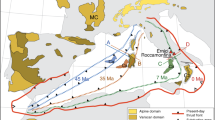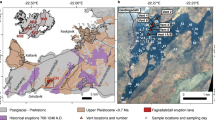Abstract
The processes responsible for the generation of partial melt in the Earth's lithospheric mantle and the movement of this melt to the Earth's surface remain enigmatic, owing to the perceived difficulties in generating large-degree partial melts at depth and in transporting small-degree melts through a static lithosphere1. Here we present a method of placing constraints on melting in the lithospheric mantle using 231Pa–235U data obtained from continental basalts in the southwestern United States and Mexico. Combined with 230Th–238U data2,3, the 231Pa–235U data allow us to constrain the source mineralogy and thus the depth of melting of these basalts. Our analysis indicates that it is possible to transport small melt fractions—of the order of 0.1%—through the lithosphere, as might result from the coalescence of melt by compaction4 owing to melting-induced deformation5. The large observed 231Pa excesses require that the timescale of melt generation and transport within the lithosphere is small compared to the half-life of 231Pa (∼32.7 kyr). The 231Pa–230Th data also constrain the thorium and uranium distribution coefficients for clinopyroxene in the source regions of these basalts to be within 2% of one another, indicating that in this setting 230Th excesses are not expected during melting at depths shallower than 85 km.
This is a preview of subscription content, access via your institution
Access options
Subscribe to this journal
Receive 51 print issues and online access
$199.00 per year
only $3.90 per issue
Buy this article
- Purchase on Springer Link
- Instant access to full article PDF
Prices may be subject to local taxes which are calculated during checkout



Similar content being viewed by others
References
Leeman, W. P. & Harry, D. L. A binary source model for extension-related magmatism in the Great Basin, western North America. Science 262, 1550–1554 (1993).
Asmerom, Y. The Th-U fractionation and mantle structure. Earth Planet. Sci. Lett. 166, 163–175 ( 1999).
Asmerom, Y. & Edwards, R. L. U-series isotope evidence for the origin of continental basalts. Earth Planet. Sci. Lett. 134, 1–7 (1995).
Kohlstedt, D. L. & Zimmerman, M. E. Rheology of partially molten mantle rocks. Annu. Rev. Earth Planet. Sci. 24, 41–62 ( 1996).
McKenzie, D. The generation and compaction of partially molten rock. J. Petrol. 25, 713–765 ( 1984).
Pickett, D. A. & Murrell, M. T. Observations of 231Pa/235U disequilibrium in volcanic rocks. Earth Planet. Sci. Lett. 148, 259–271 ( 1997).
Perry, F., Baldridge, W. & DePaolo, D. Role of asthenosphere and lithosphere in the genesis of Late Cenozoic basaltic rocks from the Rio Grande rift and adjacent regions of the southwestern United States. J. Geophys. Res. 92, 9193–9213 (1987).
Menzies, M., Kyle, P., Jones, M. & Ingram, G. Enriched and depleted source components for tholeiitic and alkaline lavas from Zuni-Bandera, New Mexico: inferences about intraplate processes and stratified lithosphere. J. Geophys. Res. 96, 13645– 13671 (1991).
Lynch, D. J., Musselman, T. E., Gutmann, J. T. & Patchett, P. J. Isotopic evidence for the origin of Cenozoic volcanic rocks in the Pinacate volcanic field, northwestern Mexico. Lithos 29, 295–302 (1993).
Goldstein, S. J., Murrell, M. T. & Williams, R. W. 231Pa and 230Th chronology of mid-ocean ridge basalts. Earth Planet. Sci. Lett. 115, 151–159 (1993).
Lundstrom, C. C., Gill, J., Williams, Q. & Hanan, B. B. Investigating solid mantle upwelling beneath mid-ocean ridges using U-series disequilibria. II. A local study at 33 oS Mid-Atlantic Ridge. Earth Planet Sci. Lett. 157, 167–181 (1998).
Bourdon, B., Joron, J.-L., Christelle, C.-I. & Allegre, C. J. U-Th-Pa-Ra systematics for the Grande Comore volcanics; melting processes in an upwelling plume. Earth Planet Sci. Lett. 164, 119–133 (1998).
Thompson, G. A. & Zoback, M. L. Regional geophysics of the Colorado Plateau. Tectonophysics 61, 149–181 (1979).
Alibert, C. Peridotite xenoliths from western Grand Canyon and the Thumb; a probe into the subcontinental mantle of the Colorado Plateau. J. Geophys. Res. 99, 21605–21620 ( 1994).
Robinson, J. A. & Wood, B. J. The depth of the spinel to garnet transition at the peridotite solidus. Earth Planet Sci. Lett. 164, 277–284 (1998).
Beattie, P. Uranium–thorium disequilibria and partitioning on melting of garnet peridotite. Nature 363, 63– 65 (1993).
LaTourrette, T. Z., Kennedy, A. K. & Wasserburg, G. J. Thorium-uranium fractionation by garnet: Evidence for a deep source and rapid rise of oceanic basalts. Science 261, 739–742 (1993).
Lundstrom, C. et al. Compositional controls on the partitioning of U, Th, Ba, Pb, Sr and Zr between clinopyroxene and haplobasaltic melts: implications for uranium series disequilibria in basalts. Earth Planet. Sci. Lett. 128, 407–423 ( 1994).
Salters, V. J. M. & Longhi, J. Trace element partitioning during the initial stages of melting beneath mid-ocean ridges: Earth Planet . Sci. Lett. 166, 15– 30 (1999).
Wood, B. J., Blundy, J. D. & Robinson, J. A. The role of clinopyroxene in generating U-series disequilibrium during mantle melting. Geochim. Cosmochim. Acta 63, 1613–1620 ( 1999).
LaTourrette, T. Z. & Burnett, D. S. Experimental determination of U and Th partitioning between clinopyroxene and natural and synthetic basaltic liquid. Earth Planet. Sci. Lett. 110, 227–244 (1992).
Hirschmann, M. M. & Stolper, E. M. A possible role for garnet pyroxenite in the origin of the “garnet signature” in MORB. Contrib. Mineral. Petrol. 124, 185–208 (1986).
Williams, R. W. & Gill, J. B. Effect of partial melting on uranium decay series. Geochim. Cosmochim. Acta 53, 1607–1619 (1989).
Spiegelman, M. & Elliott, T. Consequences of melt transport for uranium series disequilibrium in young lavas. Earth Planet. Sci. Lett. 118, 1–20 (1993).
Navon, O. & Stolper, E. Geochemical consequences of melt percolation: the upper mantle as a chromatographic column. J. Geol. 95, 285–307 ( 1987).
McKenzie, D. (230Th/ 238U) disequilibrium and the melting process beneath ridge axes. Earth Planet. Sci. Lett. 72, 81–91 (1985).
Riter, J. C. A. & Smith, D. Xenolith constraints on the thermal history of the mantle below the Colorado Plateau. Geology 24, 267–270 ( 1996).
Pickett, D. A., Murrell, M. T. & Williams, R. W. Determination of femtogram quantities of protactinium in geologic samples by thermal ionization mass spectrometry. Anal. Chem. 66, 1044–1049 ( 1994).
Edwards, R. L., Cheng, H., Murrell, M. T. & Goldstein, S. J. Protactinium-231 dating of carbonates by thermal ionization mass spectroscopy: implications for the causes of Quaternary climate change. Science 276, 782–786 ( 1997).
Acknowledgements
We thank V. Salters, C. Lundstrom and D. Pickett for comments on the manuscript and M. Spiegelman, M. Reagan and D.L. Kohlstedt for discussions. We also thank the US Park Service for access. This work was and is being supported by the US National Science Foundation.
Author information
Authors and Affiliations
Corresponding author
Rights and permissions
About this article
Cite this article
Asmerom, Y., Cheng, H., Thomas, R. et al. Melting of the Earth's lithospheric mantle inferred from protactinium– thorium–uranium isotopic data. Nature 406, 293–296 (2000). https://doi.org/10.1038/35018550
Received:
Accepted:
Issue Date:
DOI: https://doi.org/10.1038/35018550
This article is cited by
-
Improvements in the determination of attogram-sized 231Pa in dissolved and particulate fractions of seawater via multi-collector inductively coupled plasma mass spectrometry
Progress in Earth and Planetary Science (2023)
-
207Pb–208Pb decoupling of alkali feldspar from a late Mesozoic A-type granite in eastern China
Mineralogy and Petrology (2008)
Comments
By submitting a comment you agree to abide by our Terms and Community Guidelines. If you find something abusive or that does not comply with our terms or guidelines please flag it as inappropriate.



